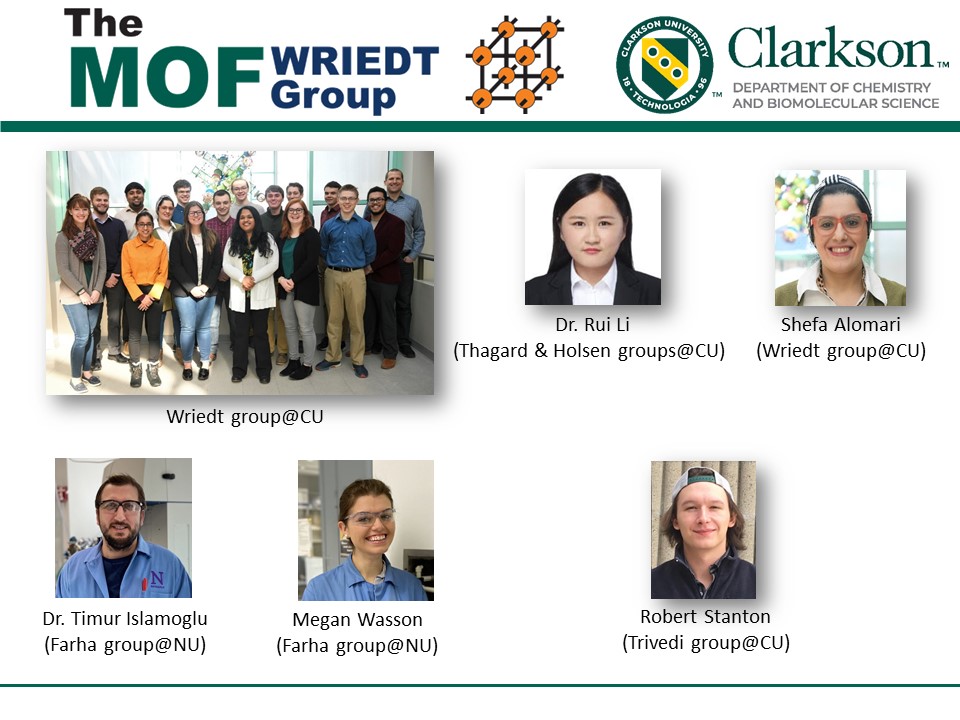The research group of Clarkson University Associate Professor of Chemistry & Biomolecular Science and Kodak CAMP Distinguished Professor Mario Wriedt has co-published a paper about PFAS removal in the top-tier academic journal Chemistry of Materials.

The project was co-led by Jean S. Newell Distinguished Professor of Engineering Thomas M. Holsen, Associate Professor of Chemical & Biomolecular Engineering and Richard and Helen March Endowed Professor Selma Mededovic Thagard, and Assistant Professor of Physics Dhara J. Trivedi.
The paper by the MOF Wriedt Group Functional Materials Design & X-ray Diffraction Laboratory et al. details new research to remove PFASs (per- and polyfluoroalkyl substances) from contaminated water.
PFASs are a group of man-made chemicals, also known as forever chemicals, that includes PFOA, PFOS, GenX, and other chemicals, which are very persistent in the environment and human body, and can lead to adverse health effects. PFASs are found in the blood of people and animals all over the world and have been linked to kidney and testicular cancers, thyroid disease, and low birth weight and immunotoxicity in children.
The manufacture and disposal of PFAS-containing formulations and products have resulted in contamination of groundwater and drinking water supplies, which is particularly problematic due to the lack of effective treatment technologies to remove PFASs from contaminated water.
“Our multiple collaborator team found that a new MOF (metal-organic framework) material can adsorb PFAS with ultra-high capacities from contaminated water bodies,” says Wriedt. “It also works rapidly and is fully reversible, meaning we can use the material over and over again. Currently, there are no other processes out there with these qualities.”
Pre-concentration of PFAS is a crucial process due to the large volume of wastewater to be treated. Following desorption, smaller volumes of the concentrated stream can be treated, for example, by the plasma process. Activated carbons are also cheap and state-of-the-art PFAS sorbents, but they only show limited adsorption capacities coupled with slow uptake kinetics. Also, their regeneration capabilities are very limited.
The team, who all work with adsorption-based technologies, decided to try MOF materials to remove PFASs. “We did preliminary testing and found it worked quite well,” Wriedt says. “The materials we use are one of the best technologies out there. We can fully get PFAS off the MOF sorbent and then reuse our material for the next batch of PFAS removal.”
“This is not only cutting-edge applied research, but it is also a great example of the productivity of multiple collaborator team here at Clarkson,” says Wriedt. “Colleagues and students from Chemistry, Physics, Chemical & Biomolecular Engineering, and Civil & Environmental Engineering have all been involved.”
Chemical and Biomolecular Engineering research associate Dr. Rui Li performed all of the hands-on testing of the MOF materials in collaboration with Chemistry & Biomolecular Ph.D. candidate Shefa Alomari.
Physics graduate student Robert Stanton performed the computer modeling of the PFAS-MOF interactions. “Robert modeled the interactions on an atomic level to show us why the material is outstanding,” says Wriedt.
A team from Northwestern University, where this specific MOF MU1000 was discovered several years ago, provided the MOF and performed additional testing.
Wriedt says that PFASs are still an emerging contaminant, which are found everywhere, especially at current and former U.S. Air Force training sites. It’s also an issue in landfills. “PFASs are also found in the leachate of landfill sites,” he says. “We hope to use our research to eventually treat this leachate as well.”
An abstract of the article is available at https://pubs.acs.org/doi/abs/10.1021/acs.chemmater.1c00324.
https://www.clarkson.edu/news/clarkson-university-research-team-details-new-toxin-removal-process